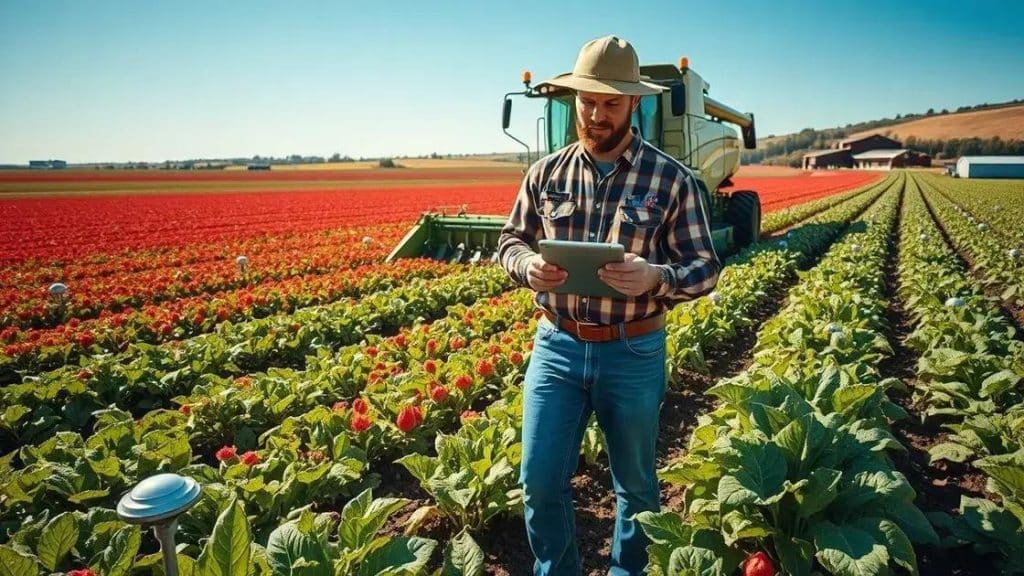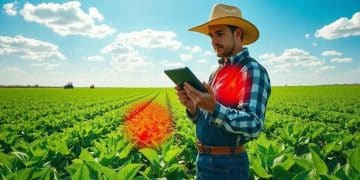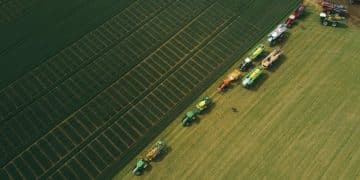Machine learning in weed detection: A farmer’s ally

Machine learning in weed detection enhances agricultural efficiency by accurately identifying and managing weeds, allowing farmers to optimize herbicide use and improve crop yields sustainably.
Machine learning in weed detection is changing the game for farmers everywhere. Have you ever wondered how technology can help with one of agriculture’s biggest challenges? In this article, we’ll delve into the innovations that make weed management smarter and more efficient for everyone.
Understanding machine learning in agriculture
Machine learning in agriculture is a fascinating topic that is gathering attention. It uses advanced algorithms to help farmers make smarter decisions. This technology can help improve crop management, yield predictions, and even pest control.
What is machine learning?
Simply put, machine learning is a branch of artificial intelligence that enables computers to learn from data. Instead of being programmed with specific rules, these systems analyze patterns and make predictions. For example, in agriculture, machine learning can predict weather patterns, optimizing planting schedules.
Benefits of machine learning in agriculture
The benefits of using machine learning in farming are numerous:
- Increased efficiency: Machine learning helps farmers save time by analyzing large amounts of data quickly.
- Better crop yields: By predicting crop performance, farmers can adjust practices to improve harvests.
- Pest resistance: Machine learning can identify pest threats before they become a problem, allowing for proactive measures.
- Sustainability: Enhanced decision-making leads to better use of resources, reducing waste and environmental impact.
Farmers who adopt machine learning techniques can significantly boost productivity and sustainability. This approach helps them stay ahead in a competitive market. By analyzing various data points, such as soil health, weather conditions, and market trends, they can make informed choices that directly affect their success.
As the agriculture industry evolves, it is crucial to embrace technology. Farmers can harness the power of machine learning to not only increase their productivity but also contribute to more sustainable farming practices. Understanding how machine learning works is the first step toward benefiting from its applications in agriculture.
How machine learning improves weed detection

Machine learning is revolutionizing how we approach weed detection. This technology can analyze data faster and more accurately than human methods. By using advanced algorithms, farmers can identify and manage weeds more effectively, leading to better crop yields.
How does machine learning work in weed detection?
Machine learning systems learn from data sets, improving their performance over time. They can recognize patterns in images of weeds and crops. When a farmer takes a photo of a field, the system can immediately identify weeds and suggest appropriate actions.
Techniques used in weed detection
Several techniques enhance weed detection:
- Image recognition: Algorithms analyze images to differentiate between crops and weeds.
- Remote sensing: Drones can capture images of large fields, allowing for quick assessments.
- Data integration: Machine learning combines data from various sources like soil moisture and weather forecasts to make accurate predictions.
The benefits of these techniques are significant. Farmers can reduce herbicide usage, saving money and promoting environmental sustainability. For instance, targeted spraying only where weeds are detected minimizes chemical use, protecting the surrounding ecosystem. This approach not only improves the health of the crops but also conserves valuable resources.
Furthermore, the use of machine learning allows for continuous improvement. As more data is collected, the system becomes smarter. Farmers benefit from having a tool that adapts to changing conditions and challenges in their fields.
Real-life applications of weed detection technology
The real-life applications of weed detection technology showcase its impact on modern agriculture. Farmers around the world are using this technology to enhance their weed management practices. From small farms to large agricultural operations, the benefits are clear and significant.
Precision agriculture
One major application of weed detection is in precision agriculture. This approach leverages technology to apply herbicides only where necessary. By reducing chemical use, farmers can save money and minimize environmental harm. For example, a field sensor may detect weed clusters and signal for targeted herbicide application.
Autonomous vehicles
Another exciting development is the use of autonomous vehicles equipped with weed detection systems. These machines can roam fields and identify weeds without human intervention. Farmers are seeing great results, as these vehicles can operate around the clock. This not only boosts efficiency but also frees up labor for other tasks.
Machine learning algorithms
Machine learning algorithms enhance weed detection technology by improving accuracy over time. As they process more data, their ability to distinguish between crops and weeds increases. This leads to better management decisions. For example, a system might learn to recognize specific weed species prevalent in a region, allowing for more effective control measures.
Integration with farm management software
Many farmers are integrating weed detection technology with farm management software. This combination allows them to track weed patterns and analyze their data. By observing trends, they can adjust their strategies, optimizing their approaches to weed management. Having this data readily available empowers farmers to make informed decisions.
Additionally, the feedback loop created by this technology continuously improves the way farmers manage their fields. By taking proactive measures based on accurate data, the entire farming process becomes more sustainable and productive. As weed detection technology continues to evolve, its applications will expand, offering even greater potential for the agriculture industry.
Future trends in machine learning for agriculture

The future trends in machine learning for agriculture promise exciting advancements that could significantly change farming practices. As technology progresses, farmers can expect more effective tools to enhance productivity and sustainability.
Predictive analytics
One major trend is the growth of predictive analytics. This technology allows farmers to forecast crop yields and pest outbreaks based on historical data. By leveraging machine learning algorithms, farmers can make informed decisions about when to plant and harvest their crops.
Enhanced automation
Automation is another key trend. More agricultural machines are being equipped with machine learning capabilities, allowing them to operate independently. For instance, autonomous tractors can identify weeds and apply herbicides directly, reducing waste and improving crop health. This shift will lead to more efficient farming and reduced labor costs.
Smart irrigation systems
The development of smart irrigation systems is also on the rise. These systems utilize machine learning to analyze soil moisture levels and weather patterns, ensuring that crops receive the precise amount of water they need. This not only conserves water but also leads to healthier plants and better yields.
Data integration
Integration of various data sources is pivotal for the future. Farmers will increasingly use data from weather stations, satellites, and sensors in their fields. Using machine learning, this data can be synthesized to provide actionable insights. These insights help farmers react promptly to changing conditions.
As these trends develop, farmers who embrace machine learning will have a competitive edge. Staying ahead of new technologies allows them to optimize their operations and adapt to the demands of a changing climate and market. The integration of machine learning into agriculture is more than just a trend; it’s transforming the entire industry.
In conclusion, the future of machine learning in agriculture is bright and full of potential. Farmers who embrace these technologies will see numerous benefits. From improving weed detection to enhancing crop yields, machine learning is transforming farming practices. As these trends continue to evolve, they promise to make agriculture more sustainable and efficient. The innovations we see today are just the beginning, paving the way for a more productive farming future.
FAQ – Frequently Asked Questions about Machine Learning in Agriculture
How does machine learning improve weed detection?
Machine learning analyzes data quickly to identify weeds versus crops accurately, helping farmers apply herbicides only where needed.
What are predictive analytics in agriculture?
Predictive analytics uses historical data to forecast crop yields and potential pest issues, enabling better decision-making for farmers.
What role do autonomous machines play in modern farming?
Autonomous machines equipped with machine learning can operate independently, performing tasks like weed detection and herbicide application.
How can farmers integrate data sources to enhance their operations?
Farmers can combine data from weather stations, soil sensors, and satellite imagery to make informed decisions and improve crop management.





